A LITTLE PIECE OF CANADA...Gile Flowage offers fish, scenery
By Dick Ellis
Reader Note: When reading any of Dick Ellis’s 1200 Wisconsin journeys taken over two decades as a syndicated columnist, be sure to check current regulations when planning the trip yourself. The following trip to the Gile Flowage was taken in 2007.
From an isolated cabin in the wilds of Iron County near Mercer, our truck plodded north toward the Gile Flowage. Dust from the dirt and gravel road rose in our wake, and a snapping turtle on maternity leave once stopped the journey completely. With my brothers Steve Ellis of Wausau and John Ellis of Muskego, I was destined for an introduction, as described by DNR Senior Fisheries Biologist Jeff Roth, “with a little piece of Canada.”
“The large outcropping of granite rock on the Gile Flowage is characteristic of the Canadian shield waters,” said Roth, who works in Ashland and Iron Counties. “The lack of shoreline development is very appealing. It strikes everyone out on the Gile for the first time. It’s probably the most aesthetic lake in Wisconsin.”
Located in northeastern Iron County within the Lake Superior watershed, the 3,384 acre Flowage is fed by the west fork of the Montreal River and six other tributary streams. Twenty-six miles of shoreline is characterized by numerous protected bays and large outcroppings of exposed bedrock. Islands, exposed and hidden timber and boulders decorate the water and despite providing hazards for the unfamiliar boater, also add to its great appeal as an isolated, beautiful fishery.
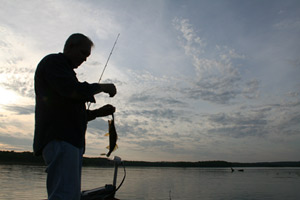 |
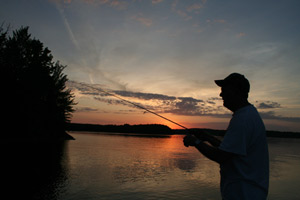 |
| Steve Ellis is ready to release a Gile Flowage walleye that hit a gold rapala. | John Ellis jigs a Gile Flowage shoreline at sunset June 11th for smallmouth bass and walleye. |
The flowage began filling in 1941 with the creation of a dam by the then Lake Superior District Power Company. Initially, the fishery was comprised mainly of musky and species native to the Montreal River system. Active management began in mid 1950s, including numerous musky and walleye stockings. The first state fisheries survey completed in 1973 verified that walleye was clearly the dominant species.
Self-sustaining populations of both smallmouth and walleyes are the principal gamefish today. The flowage though, now sustains less than three adult walleyes per acre despite a goal of four to six adult walleyes per acre. Local anglers, Roth said, are protective of the walleye population that most perceive as the most desirable angling species in the flowage. Many also believe the walleye has suffered in competition with a high numbers of smallmouth bass first stocked by the DNR in 1985.
Protective smallie regulations including a 15 inch minimum and two fish limit on a relatively unknown fishery with light angling pressure quickly led to “superb” smallie fishing with fish between 18 and 22 inches six or seven after stocking routinely taken. The number of trophy class fish over the years has declined with angling pressure, but the Gile retains its reputation as an exceptional smallmouth fishery.
“Because the population was abundant and the smallmouth here are so robust, much like the football fish in the Flambeau Flowage, and because of the aesthetics of the flowage people target smallmouth,” Roth said. “The Gile Flowage has gained a statewide reputation as a premier smallmouth bass fishery. It has become a travel destination for anglers seeking high-quality bass fishing in a scenic environment.”
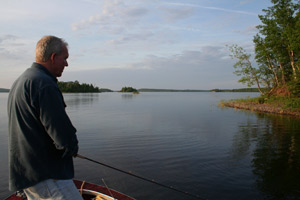 |
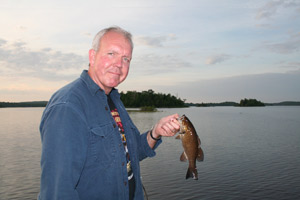 |
| Isolation, good fishing and aesthetics marked by rock outcroppings, timber and islands make the 3300 acre Gile Flowage a pleasant northern Wisconsin visit. | |
Because smallmouth bass and walleyes utilize different habitat and forage, Roth believes the decline in walleye numbers likely correlates instead with often drastic water drawdowns in summer and winter by current dam operators Xcel Energy to facilitate hydroelectric power production downstream. Drawdown, he said, have directly contributed to a severe winter mortality rate for Gile walleyes and panfish. Normal over-winter walleye mortality rates would be 11 to 17 percent. Roth said the Gile experiences 20-40 percent winter kill. Drawdowns may be responsible for poor survival of young walleyes that pass downstream through the dam and by increased cannibalism by adult walleyes made possible by a drastic reduction in the winter pool area.
Due to the problem, in the past the state has encouraged Xcel Energy to more closely monitor drawdowns and will initiate negotiations to explore the possibility of reducing winter drawdowns to a level less damaging to walleye recruitment and the overall fishery. Because drawdowns are also harmful to habitat imperative to the survival of young panfish, and because bluegills are believed to be preying on the exotic spiny water flea more moderate water drawdowns are considered crucial to the fishery. The flowage is the only inland lake in Wisconsin (since 2003) where the spiny water flea is known to have infiltrated.
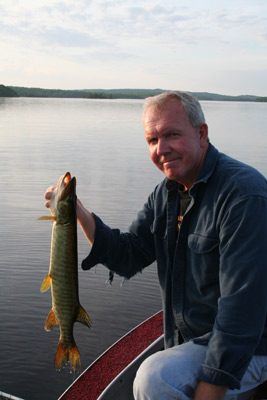 |
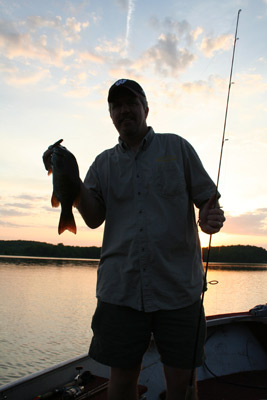 |
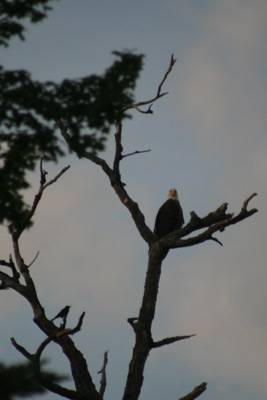 |
| The Gile Flowage population of muskies is sustained only through stocking, according to DNR fisheries biologists. This small fish about to be released by Steve Ellis cooperated June 11. | Writer Ellis puts down the camera long enough to catch a smallmouth or two that came up to hammer surface baits on the Gile Flowage near Hurley June 11. | Good fishing, scenery and wildlife like this bald eagle make fishing the Gile Flowage in Iron County a pleasing trip. |
During our journey June 11, we caught everything one would expect from the Gile after an interview with Roth. A lone walleye, two pike and a small musky were welcomed aboard and quickly released. And an abundance of smallmouth willing to take anything from a jig and crawler to rapalas and surface baits, in particular as the sun fell on the beautiful rock outcroppings and islands, also cooperated.
Had we caught nothing, we still would have caught it all. A little piece of Canada, indeed, lies not far from Hurley in northeastern Iron County.
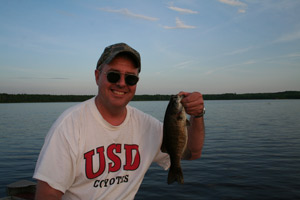
John Ellis releases a smallmouth bass on the Gile Flowage. Northern pike, one musky and a walleye also visited during a three hour trip June 11th.
For more information on the Gile Flowage or the Turtle Flambeau Flowage, other fishing opportunities in Iron County, or lodging, dining and entertainment information, contact:
The Hurley Area Chamber of Commerce at www.hurleywi.com or 715-561-4334 or Jessica Bolich at info@hurleywi.com.
The Mercer Area Chamber of Commerce at www.mercercc.com or 715-476-2389 or Tina Brunell at info@mercercc.com.
Iron County Development at www.ironcountywi.com or 715-561-2922 or Jenni Kallas at jenni@ironcountywi.com.
PREDATOR GILLS THE ANSWER TO INVASIVE SPINY WATER FLEA?
The Gile Flowage, according to DNR Senor Fisheries Biologist Jeff Roth, serves as a water retention reservoir for downstream hydroelectric facilities at Saxon Falls and Superior Falls on the Montreal River. Water levels vary considerably and are manipulated by Xcel Energy in response to seasonal precipitation and demands of the two downstream hydroelectric operations. Drawdowns have historically varied on average from eight to 12 feet but more recently have been as drastic as 14 feet.
Despite five public landing throughout the flowage, launching a boat in fall can be an extremely difficult proposition due to low water levels. But it is the escalating popularity since 1985 of the flowage as a smallmouth fishery that likely contributed to the introduction in 2003 of an exotic species of zooplankton native to northern Europe often transferred via trailored boats. The Gile is the only inland lake in Wisconsin known to hold the Spiny Water Flea.
The Spiny Water Flea according to a report authored by DNR fisheries expert Craig Roesler at Hayward, are predacious, feeding on other zooplankton. They cause shifts in the native zooplankton community that may impair recruitment of juvenile fish into the adult population.
Roth said he believes he could predict where the invasive flea will appear next, beginning with bass lakes to the south in Vilas County. He said it is imperative that boaters follow instructions for cleaning their boats at all landings so that they do not contribute to that migration south.
Roth sees a possible silver lining in the negative situation. The state, according to data authored by Roth and DNR Fisheries Team Leader Dave Neuswanger at Hayward, began stocking bluegills and pumpkinseed averaging 4-1/2 inches from Mercer Lake into the Gile Flowage in 2005. Stocking was initiated to enhance the panfish populations but also with the knowledge that gills as predators seemed to be the reason for the complete disappearance of spiny water fleas established in Fish Lake near Duluth, Minnesota.
“Last year on the Gile Flowage there was phenomenal bluegill fishing with eight to 10 inch fish caught with regularity,” Roth said. “The Spiny Water Flea population seems to be declining. Gills were stocked as a potential control of the Spiny Water Flea. It seems like it’s working. But we don’t know.”
SIDEBAR END
GILE MUSKIES LOW IN NUMBER, GROWING IN SIZE
Roth said the Flowage supports a musky population but said the fish are only sustained through state stocking. There is no indication of natural reproduction. A 2003 survey estimated musky density at a low 0.1 adults per acre, less than half the desired number.
The minimum length limit for muskies was increased from 34 inches to 40 inches in 1992. A “pre-impact” survey performed in 1993 revealed that only 10 percent of adult muskies were 40 inches or longer. After ten years under the higher length limit, the 2003 survey revealed that 25 percent of the musky population was 40 inches or longer.
From creel surveys taken periodically on the flowage from 1975 through 1997, it was determined that fishing pressure on the Gile is a scant five hours per acre per year. By comparison, another fishery with low pressure, the Flambeau Flowage, receives 14 hours of angling pressure per acre per year.
SIDEBAR END







